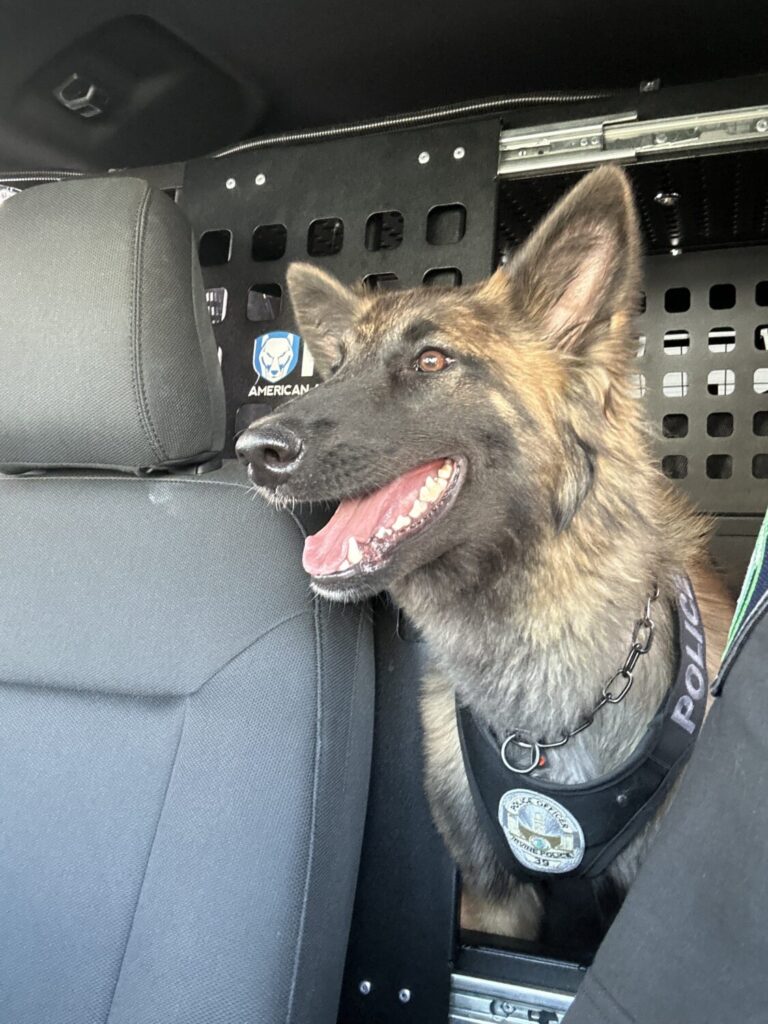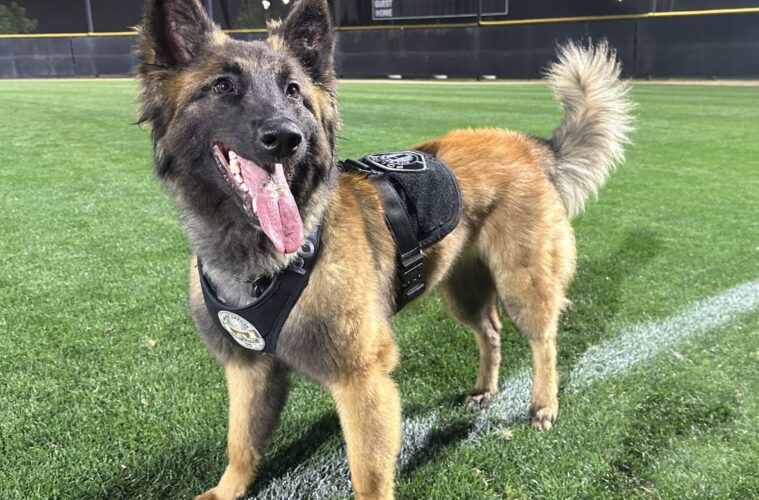Sporting a playful grin along with a fluffy, brownish-gray coat, Irvine Police Department’s newest four-legged K-9 recruit Lincoln is eagerly displaying dedication to local police work. At just 15-months-old, Lincoln has become the youngest K-9 to enlist in Irvine law enforcement, and has become the Irvine K-9 Unit’s first female police dog.
In the years to come, the 50-pound Belgian Tervuren from the Czech Republic will be trained to detect explosives, which will also be a first for the department.

K-9 Lincoln. (Photo courtesy of Irvine Police Department)
Officer Chris Cameron, K-9 Handler with the Irvine Police Department, was able to select Lincoln to be his newest partner. The two will work together for the foreseeable future and Cameron has plans for her to join his own pack of rescue dogs once her shift is over.
“She’ll work with me until I retire. I’ll probably stay eight or nine years, now that I have her,” he explained. “My hope is to keep the dog healthy, give it a good career,” he said. “Then once it retires, give it a good three to four years to just be a dog.”
Three months into their partnership, Cameron said Lincoln is always happy and ready to work, which is a characteristic he recognized from the start. Recalling her trial run with the department at the kennel, Cameron said Lincoln’s relaxed demeanor and easy going attitude helped solidify an automatic connection between the pair.
“Just watching her walk with the kennel assistant bringing her out — once I got her on the leash, it was easy. She was just like, ‘OK, you are my dad, let’s go have some fun,’” he said. “It was very much like a tail wag — just kind of this happy disposition about herself.”
Having worked with two previous K-9 partners outside of Irvine, Cameron wanted to be deliberate in his selection process. In this respect, size, gender and sociability all played an important role.
“I specifically wanted a smaller dog — having to carry your dog or lift them over a fence, or lift them into an attic — I didn’t want to lug an 80 to 90-pound dog,” Cameron explained to Irvine Weekly.
While the practice of employing female police dogs is not uncommon today, Cameron explained that views were different in the past, adding that misconceptions regarding a K-9’s gender and their ability to do police work led to more male dogs commonly used.

Lincoln on patrol. (Photo courtesy of Irvine Police Department)
“When I started as a handler in 2006, the mindset in the handler community was that if it was a good quality female dog, we want to use that for breeding to produce offspring. Back then it was kind of unheard of to see departments with female police dogs,” he said.
However, things have changed. Now, handlers are able to pick specific attributes from their working dog vendors.
“One of the features of my previous dog that I wasn’t too fond of was that male dogs like to mark their territory – so if you’re searching an open area, and he’s marking every bush he sees – it can be a little frustrating. Females don’t really tend to be markers.”
While the two may be inseparable for the time being, Cameron is now tasked with developing the young puppy into a working asset for Irvine law enforcement.
“Some of the challenges I faced with her as a handler was that she was 80% police dog and about 20% puppy,” he said. “I need to understand that she’s a puppy, but on the flip side I feel like we’re getting a solid dog at a young age that’s going to serve the community a lot longer.”
From Cameron’s perspective, things are going well.
“She’s just a happy dog. She loves coming into the station, she loves when people pet her, she has very much like a light switch – if we need to find somebody, she’s game,” he said. “She’s all work.”

Training Day. (Photo by Stephanie Romero)
Yet, despite the strides in law enforcement education training being achieved by the Cameron and Lincoln duo in Irvine, there are legislative efforts to ban the use of police dogs.
Assembly Bill 742 states that the use of canines in law enforcement can be seen as an excessive use of force, and contends that the presence of dogs can cause people to be fearful and “distrust the police.”
The bill also pushes to ban the use of unleashed K-9s in police work in an effort to prevent serious bodily injuries to an individual, unless that individual is posing a threat to the officer’s life.
Per IPD’s use of force policies, Cameron explained the deployment of K-9s is viewed as a last case scenario and is only considered if there is an imminent threat to officers, the community, or if a suspect is actively resisting an arrest.
“As a handler, I have to evaluate what kind of crime we have, and how severe it is. Certainly if we have a violent crime, like an auto theft with a pursuit, we have to evaluate what kind of threat the person poses to the community,” he said.
Contrary to AB742, Cameron pointed out that K-9 officers have the ability to command the dog to stand down if necessary.
“From a deployment standpoint, one of the best benefits of the police dog, aside from the mere presence of that dog — if the circumstances justify a deployment of that dog — a police dog is the only less than lethal force option we have. For example, if someone is trying to assault us – once I make the decision to use a taser, and it is deployed — those darts are going out and striking the suspect,” he said. “Whereas, a police dog, I could have the same deployable-crime situation, but once it’s sent down range and the suspect gives up, I can recall the dog, have it come back to me, and no force is ever applied.”
As the officer and K-9 counterpart continue to develop their partnership, Cameron hopes to hone Lincoln’s natural instincts in an effort to bring nuance to local law enforcement.
“Our jobs [as officers] are becoming much more complex and dynamic. In all these critical incidents, it’s pretty remarkable how the presence of a police dog, even just seeing my police car show up — tends to de-escalate the critical incidents we’re involved in,” he explained. “So, having that psychological tool with us is a significant benefit.”
Alternatively, Cameron added that K-9s can also help act as a conduit for the community. As one of three K-9 handlers working with the Irvine Police, Cameron has a unique role within the community and hopes Lincoln can help erode barriers between the public and law enforcement.
“A lot of people support the police, but they don’t know how to break that ice and go up to a police officer, but almost daily, when a kid or somebody in the community sees my uniform that says ‘K-9,’ they want to come up and start talking about dogs,” he said. “They want to see the dog and pet the dog, so I think it’s an incredible tool to build that bridge and partnership with our community.”
Advertising disclosure: We may receive compensation for some of the links in our stories. Thank you for supporting Irvine Weekly and our advertisers.

